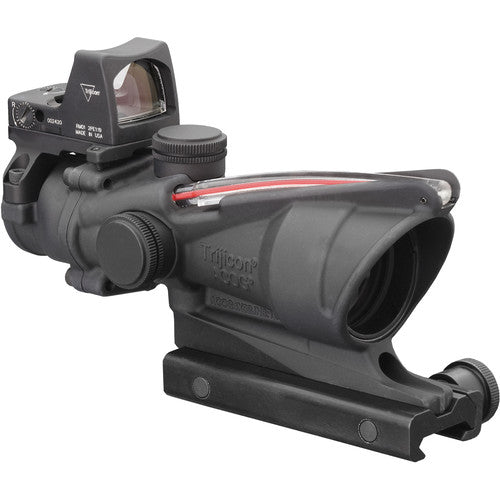

Trijicon ACOG 4x32 Dual Illuminated Riflescope features a robust optical system tailored for both short-range and long-range shooting. With a 4x magnification and a 32mm objective lens, it delivers a clear field of view of 36.8 feet at 100 yards. The dual-illuminated reticle system combines fiber optics and tritium, ensuring a bright aiming point in any lighting condition without the need for batteries. The .223 BDC reticle allows for precise bullet drop compensation up to 800 meters, enhancing shooting accuracy without manual adjustments.
Complementing the ACOG is the Trijicon RMR Type 2 red dot sight with a 3.25 MOA dot, facilitating rapid target acquisition for close-quarter engagements. Built from durable, matte black 7075-T6 aircraft-aluminum alloy, this system is designed to withstand harsh conditions and recoil. Nitrogen-filled to prevent fogging, this riflescope is waterproof, meeting military standards for rugged performance.
Key Features:
- DUAL ILLUMINATION SYSTEM: Combines fiber optics and tritium for a bright reticle in any lighting condition, eliminating the need for batteries in the main scope.
- BULLET DROP COMPENSATION: .223 BDC reticle allows for accurate shooting up to 800 meters without manual adjustments, enhancing long-range precision.
- VERSATILE COMBO: 4x32 ACOG for magnified precision shooting and 3.25 MOA RMR Type 2 for rapid target acquisition in close-quarter situations.
- RUGGED CONSTRUCTION: Forged 7075-T6 aircraft-aluminum alloy housing ensures durability in extreme conditions, withstanding recoil from various calibers.
- WATERPROOF PERFORMANCE: Nitrogen-filled to prevent internal fogging, with waterproof capabilities exceeding military standards.
- BOTH EYES OPEN DESIGN: Utilizes the Bindon Aiming Concept (BAC) for improved situational awareness and faster target acquisition.
- ADJUSTABLE RMR: The RMR Type 2 features adjustable LED brightness settings for optimal visibility in varying light conditions.
- MULTI-COATED LENSES: High-quality glass with multi-coated lenses maximizes light transmission for exceptional clarity and zero distortion.
Technical Specifications
| Specification | Detail |
|---|---|
| Model | TA31-C-100550 |
| Magnification | 4x |
| Objective Lens Diameter | 32 mm |
| Reticle | Red Crosshair .223 / RMR 3.25 MOA Red Dot |
| Illumination | Dual (Fiber Optics & Tritium) |
| Field of View | 36.8 ft @ 100 yards |
| Eye Relief | 1.5 inches |
| Length | 5.8 inches |
| Weight | 15.1 oz (without RMR) |
| Adjustment Click Value | 1/2 MOA |
| Exit Pupil | 8.1 mm |
| Housing Material | 7075-T6 Aircraft Aluminum |
| Finish | Matte Black |
| Waterproof | Yes |
| Fogproof | Yes (Nitrogen Filled) |
| Battery | Not required for ACOG, CR2032 for RMR |
| Warranty | Limited Lifetime |
| SKU/UPC | 719307311787 |
What's in the Box?
- Trijicon 4x32 ACOG Riflescope
- Trijicon RMR Type 2 Red Dot Sight
- Mounting Hardware
- Lens Pen
- Manual
- Warranty Card
Customer Reviews
"The clarity and performance of this scope are exceptional, even in low-light conditions." - John D.
"The combination of the ACOG and RMR makes for a versatile shooting experience. Highly recommend!" - Sarah L.
"Built to last, and the reticle is easy to see in any light." - Mike T.
FAQ
Many users wonder about the performance of the Trijicon ACOG in different environments. This riflescope excels in both bright daylight and low-light settings, thanks to its dual-illuminated reticle. For maintenance, regular lens cleaning with a soft cloth and periodic checks for fogging are recommended. The durable construction makes it resistant to harsh conditions, so it requires minimal upkeep.
Comparing the ACOG to other scopes, the unique dual-illumination feature sets it apart, providing a significant advantage in varying light conditions. While some scopes require battery power, the ACOG operates without it, making it a reliable choice for tactical situations. Users often appreciate the ease of use and the precision it delivers, especially when paired with the RMR red dot sight for close-range engagements.
Similar Models
Looking for more options? Explore the complete Trijicon lineup, including models like the Trijicon AccuPoint 1-6x24 for versatile magnification and the Trijicon VCOG 1-6x24 for tactical performance. Each model is designed to meet specific shooting needs, ensuring you find the perfect fit for your shooting style.
You May Also Like
Here’s some of our most similar products people are buying. Click to discover trending style.










